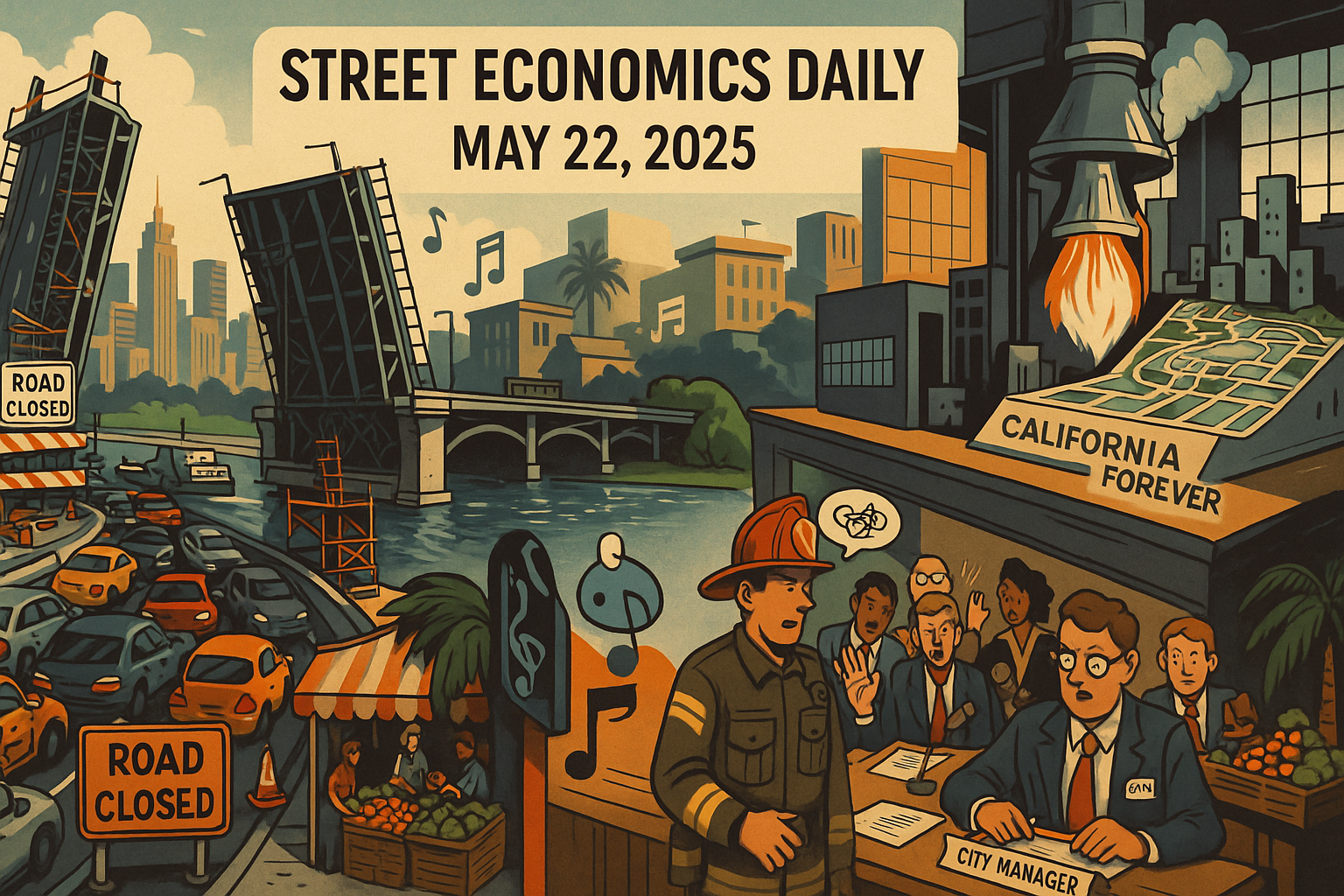Book Drop (Red Tape Empire)
Miami’s scenic Venetian Causeway might turn 100 next year before its restoration even breaks ground. In true bureaucratic form, Miami-Dade County just pushed the bridge replacement timeline out beyond 2032 – yes, another decade. Commissioners are voting on a 14th contract amendment, adding $1.3 million more (bringing design costs to $15.1M) and adjusting deadlines yet again. Blame an endless list of scope changes: island restorations, utility relocations, even a conch survey (gotta keep the mollusks happy). With 11 historic bridges needing a modern overhaul, construction won’t start until years after designs finish, then four years of work after that. At this rate, the nearly century-old causeway will be eligible for AARP before it’s fully rehabbed. At least $100 million in federal funds are lined up to help these bridges last another 75 years – if they ever get built. In the meantime, commuters can enjoy the “historic” feel of dodging potholes on their daily drive. Red tape empire, indeed.
Drama Meter Reading 9.0
A small-city power loop in Cohoes, NY exemplifies governance gone haywire. A newly elected councilman there was also a city firefighter – effectively making himself both overseer and underling of the city manager. Legal opinions summed it up as “you cannot be your own boss,” forcing the conflicted official to resign rather than continue as a one-man org-chart pretzel. Such basic chain-of-command bungling erodes investor confidence and makes productive economic policymaking nearly impossible.
BusinessFlare Take
Hollywood’s runaway production problem has Los Angeles scrambling for a fix. Mayor Karen Bass just issued an executive directive to cut costs and red tape for local film and TV shoots, basically pleading “Don’t flee to Atlanta, stay and film in LA!”. The new order slashes absurd permitting fees – like waiving charges for on-set firefighters when you’re not even using pyrotechnics. It also caps the city staff on set to just one and speeds up permit approvals for hot locations like Griffith Observatory , the Port of LA, and the Central Library. Bass wants city departments to actually talk to film producers (imagine that) about upcoming street closures or other snafus, instead of the usual bureaucratic surprise party. City assets might even be opened up as filming sites and parking lots because, well, Los Angeles has learned the hard way that if you don’t make it easy to film, producers will take their multimillion-dollar projects elsewhere. Meanwhile in Sacramento, state lawmakers are looking to sweeten the pot with bigger tax credits – potentially boosting California’s film incentive program from $330 million to a whopping $750 million. The message: Hollywood’s hometown is finally fighting to keep Hollywood at home. Cue the clapboard and hope it’s not too little too late.
Street Economics Insight
Is America really in a “loneliness epidemic”? The data says: chill out, it’s not so grim. The U.S. Census Bureau asked half a million Americans how often they feel lonely, and 60% report rarely or never. In fact, only 5% say they’re always lonely (perhaps the ones still on Facebook), and 8% usually lonely. So much for the narrative that we’re all one step from dying alone. Interestingly, loneliness – for those who do feel it – has a lot to do with geography and economics. The “always lonely” crowd clusters in the Deep South, especially Mississippi, Louisiana, and Georgia. These also happen to be high-poverty states, and indeed greater loneliness tracks closely with higher poverty rates. By contrast, folks in northern states like Minnesota, Vermont, and Iowa report rarely feeling lonely, and those states top the charts in community cohesion – think high volunteerism and lots of Elks Lodge memberships or whatever Northerners do. Washington, D.C. actually beats all 50 states in lowest loneliness, perhaps because everyone’s too busy networking. One surprise: Florida. Despite its huge retiree population (living alone = recipe for loneliness, right?), Florida had more people say they never feel lonely than almost anywhere else. Maybe sunshine and golf carts do wonders for the soul. The bottom line: social isolation is real for some, but the “epidemic” rhetoric might be overblown. Strong communities and economic health go hand in hand with feeling connected – it’s not just about individual psychology, it’s about place.
Purple Cow of the Day
Imagine a brand-new city built from scratch in California – tech billionaires’ utopian dream, complete with walkable streets and green energy. What could go wrong? As it turns out, everything. A mysterious outfit called Flannery Associates quietly bought up 60,000 acres of farmland in Solano County (near Travis Air Force Base) aiming to create a city dubbed “California Forever”. Once unmasked, the venture promised idyllic tree-lined boulevards and affordable homes. Minor catch: the plan blatantly violates the county’s growth laws, which forbid turning those cow pastures into suburbs. To proceed, the tech bros would need countywide voter approval to overturn those rules – and local voters slammed the door in their faces. So, Plan B: find a backdoor. The startup city backers started cozying up to the tiny Suisun City nearby. In January, Suisun City’s council voted to explore annexing land to “grow our community” (translation: let the billionaires glom onto the city). Opponents call the maneuver “diabolical,” essentially a bait-and-switch to dodge a county referendum. One critic noted the city manager’s talking points sounded lifted from California Forever’s PR, dubbing the whole thing “California ForNever”. After burning through goodwill with all the secrecy and some frankly tone-deaf moves (like Sramek, the 38-year-old ex-Goldman CEO of this project, donating cash to Suisun’s coffers while asking to pave over farmland), the venture’s viability is… questionable. Silicon Valley money can buy land and politicians, but can it buy a community’s trust? California Forever might last forever on paper, but in reality it’s a definite maybe at best – a purple cow that could end up a white elephant.
ECOSINT Signal
Cyber villains aren’t just targeting big federal agencies – they’re coming for City Hall now. Case in point: Abilene, Texas, which got hit by a ransomware attack that city officials suspect came from a Russia-based gang called “Qilin”. This charming group claims it stole 477 gigabytes of city data and had the nerve to demand ransom by May 27 or else. Abilene’s response? “No dice.” The city publicly stated it will not pay these extortionists a penny, sticking to the principle that you don’t negotiate with (cyber) terrorists. Since the breach was detected in April, the town’s been in digital triage – many systems offline, but essential services like 911, water, and trash pickup are still running the old-fashioned way. The hackers, likely hiding in some Eastern European basement, even posted some stolen files online to prove they mean business. Abilene residents are understandably frustrated by the disruption, but the city’s asking for patience as IT pros mop up the mess. Meanwhile, cybersecurity experts note Qilin has hit at least seven other government entities this year – they’ve been on a rampage against schools, hospitals, you name it. It’s an asymmetric threat: a handful of foreign criminals causing chaos for local U.S. communities. Consider this a wake-up call in municipal offices everywhere to beef up cyber defenses – because today it’s Abilene, tomorrow it could be your town getting an unsolicited pen-test from Russia with love.
Red River Flavor
Your bouquet might cost a bit more this year – and strangely, that could be good news for local flower farmers. How so? Thank the new tariffs on imported cut flowers, part of the current administration’s trade posturing that’s making 80% of America’s flower supply (sourced from places like Colombia, Ecuador, and the Netherlands) pricier. U.S. florists who’ve long relied on cheap imports are now hunting for domestic blooms to avoid those import taxes. Enter the local farmers, who see an opportunity to finally get their roses into grocery stores and wedding planners’ hands. But there’s a catch: after decades of globalization (back in the ’90s, the U.S. cut flower tariffs entirely to boost South American growers as part of the war on drugs deal), America’s cut-flower industry is a withered vine. “You can’t have it both ways,” as one grower put it – you can’t suddenly drive business back to U.S. farms without helping them scale up production. Right now, many small flower farms lack the greenhouse space, labor and distribution networks to meet surging demand. And compounding the challenge, farmers grumble that USDA support for local ag has been lackluster (even as consumers and florists are now desperate for domestic stems). So while tariffs might give local growers a fighting chance, they’ll need investment to actually deliver the goods. In the meantime, expect higher flower prices at the checkout counter. The upside? Perhaps more buyers will appreciate seasonal, native flowers – those not subject to tariffs – and we’ll see a renaissance of locally grown bouquets. Flower power might be coming home, but it’s going to take some green (and we don’t mean greenery) to truly blossom.
Space Economy Signal
Houston may be Space City, but Huntsville, Alabama is staking its claim as Rocket City USA – and Blue Origin just doubled down on that. Jeff Bezos’s space firm is expanding its Huntsville rocket engine factory by 200,000 square feet, on top of an existing 400,000 sq ft facility. That’s a lot more room to crank out BE-4 engines (the powerhouses for Blue Origin’s own New Glenn rocket and United Launch Alliance (ULA)’s Vulcan rocket) and perhaps BE-3U engines for New Glenn’s upper stage. The new construction permit, valued at $4.1 million, was one of the largest issued in Alabama this month. Blue Origin’s campus, spread over 46 acres in Huntsville’s Cummings Research Park , was built with “incremental expansion” in mind – translation: they knew Bezos’s space ambitions would only grow, so they’re adding more assembly lines as the rockets multiply. For Huntsville, a city that already hosts NASA’s NASA Marshall Space Flight Center and tons of aerospace contractors, this expansion means more high-tech jobs and solidifies its status as the place where rocket engines roll off the assembly line. In an era when every state and city wants a piece of the commercial space boom, Huntsville’s strategy is simple: keep delivering. They offered the workforce and business climate to land Blue Origin’s factory, and now the reward is coming in concrete and steel. If all goes well, sometime soon those engines built in Alabama will be blasting satellites (and maybe people) to orbit – local economic development with truly out-of-this-world implications.
The Music Cities
Norman, Oklahoma is going all in on a massive entertainment district as an economic catalyst. The city council just approved a phased $1 billion plan (arena, multipurpose concert venue, plaza, hotel, retail and possibly housing) with over $600 million coming from city tax-increment financing. It’s a huge public bet that a new music and sports hub will pay off in jobs, tourism and development – rather than becoming an expensive boondoggle – as city leaders hope.
About Street Economics Daily
Street Economics Daily cuts through noise, jargon, and bureaucracy to deliver sharp, actionable insights for civic and economic development professionals. Blunt, irreverent, and grounded firmly in reality, it’s essential daily reading for city leaders who refuse to settle for outdated strategies.
BusinessFlare | Street Economics | Drama Meter | The Music Cities | Goodnight’s Red River




Comments are closed